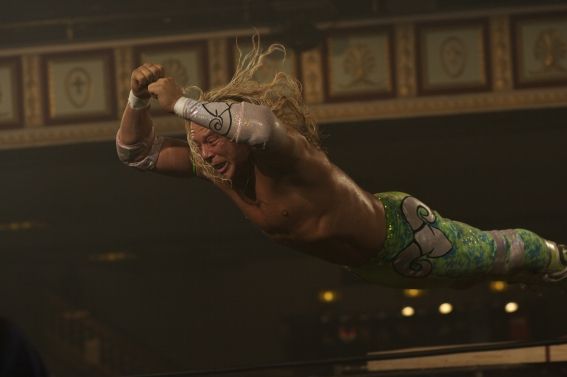The Wrestler
15In the comic world, occasionally you would see characters crossover into other titles. For instance, you could have (DC comics) Superman meet up with (Marvelís) Spiderman, and for an issue or two readers would be treated to the coming together of two worlds that rarely met. The Wrestler is the film version of this mechanic.
Darren Aronofsky has made three films (Pi, Requiem for a Dream, The Fountain); they are connected by being visually stylised, with themes that make art house crowds drool heavily into their extra hot, skinny mochaccinos. Some say his work is thought-provoking, while others dismiss it as pretentious. The truth probably lies awkwardly between the two.
And then you have Mickey Rourke. When he began his career in film in the early eighties, it was clear to everyone that he had the potential to be one of the most talented actors of his generation. He didnít just have spunk, he was spunk personified. Unfortunately for him, Hollywood is a spunk-free zone, so it quickly cast him out into the desert land. For years, no one would touch him; his attitude ignited flames that burnt down every one of his bridges. He decided to become a boxer, having spent much of his youth on the amateur boxing circuit. Unfortunately, his face saw more leather than a kinky MPís arse. Noone in their wildest dreams thought he would ever star in a film again. And then two worlds collided...

Whaddaya mean this isn't Iron Man 2? Boy, do I feel stupid.
Whatís even more amazing is that the coming together of two truly remarkable characters, resulted in a relatively unremarkable film. Thatís not to say The Wrestler isnít a really good film though, because it is. However, it is never anything more than a story of a down on his luck wrestler, who hangs out at tittie bars and hasnít seen his daughter in years. The script plays out like an adult made-for-tv film. This is not a film about a great story - this is, more importantly, a comeback within a comeback.
Mickey Rourke plays Randy ĎThe Ramí Robinson, a washed up wrestler, living in a trailer, working in a supermarket. At the weekends however, he still manages to stumble into the ring, in front of small, albeit passionate, crowds. He is the pin-up hero for all men who insist on clutching onto their past, because thatís all they have left.
He befriends Cassidy (Marisa Tomei), a Ďdancerí at his local strip bar. Their relationship becomes complex, as their friendship soon blurs with Cassidyís professional duties. On top of that, Randyís health takes a serious knockback that puts his wrestling career in doubt. On the plus side, it provides him with the opportunity to reach out to his estranged daughter Stephanie (Evan Rachel Wood).
Obviously there are painful parallels between Rourke and the character he plays. But even though Rourke has lived the bad Ďwashed upí dream for real, Aronofsky still manages to capture glimpses of the raw talent he exuded in his youth. In fact, itís fair to say that this unlikely pairing managed to bring the best out of them both, as they shine equally brilliantly in their respective roles.
Aronofsky has provided Rourke with one final lifeline, with which to prove to the world that we werenít wrong about him the first time around after all. And Rourke has allowed Aronofsky a stepping stone to a wider, slightly more mainstream audience; the kind that followed and supported the likes of Soderburgh, who now has carte blanche to move back and forth from art house to mainstream with ease.
But itís not just those two who make from it. Audiences get to see a film that oozes with great performances, and although the story is hardly original, itís the way itís told that makes it so compelling. And who knows, maybe it will open the door for that Big Daddy story to finally bellyflop its way onto our screens.
